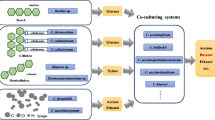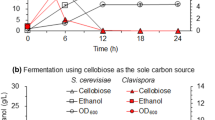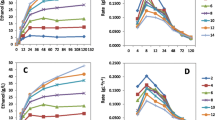Abstract
In this study, cutinase production by Thermobifida fusca WSH03-11 was investigated with mixed short-chain organic acids as co-carbon sources to demonstrate the possibility of producing high value-added products from organic wastes. T. fusca WSH03-11 was cultured with different combinations of butyrate, acetate, and lactate with a purpose of increasing cutinase activity. The optimum proportion of butyrate, acetate, and lactate was 4:1:3. In batch cultivation, acetate and lactate were consumed quickly, while the consumption of butyrate was depressed in the presence of acetate with a concentration higher than 0.5 g/L. Based on these results, a two-stage batch and fed-batch cultivation strategy was proposed: a batch culture with acetate and lactate as the co-carbon sources in the first 10 h, and then a fed-batch culture with a constant butyrate feeding rate of 12 mL/h during 11∼20 h. By this two-stage cultivation strategy, cutinase activity, dry cell weight, and consumption rate of butyrate were increased by 70%, 103.4%, and 4.3-fold, respectively, compared to those of the batch cultivation. These results provided a novel and efficient way to produce high value-added products from organic wastes.
Similar content being viewed by others
References
Purdy, R. E. and P. E. Kolattukudy (1975) Hydrolysis of plant cuticle by plant pathogens. Purification, amino acid composition, and molecular weight of two isozymes of cutinase and a nonspecific esterase from Fusarium solani f. pisi. Biochemistry 14: 2824–2831.
Egmond, M. R. and J. de Vlieg (2000) Fusarium solani pisi cutinase. Biochimie 82: 1015–1021.
Egmond, M. R. and C. J. van Bemmel (1997) Impact of structural information on understanding lipolytic function. Methods Enzymol. 284: 119–129.
Carvalho, C. M. L., M. R. Aires-Barros, and J. M. S. Cabral (1998) Cutinase structure, function and biocatalytic applications. Electron. J. Biotechnol. 1: 160–173.
Degani, O., S. Gepstein, and C. G. Dosoretz (2002) Potential use of cutinase in enzymatic scouring of cotton fiber cuticle. Appl. Biochem. Biotechnol. 102–103: 277–289.
Du, G. C., S. L. Zhang, Z. Z. Hua, Y. Zhu, and J. Chen (2007) Enhanced cutinase production with Thermobifida fusca by two-stage pH control strategy. Biotechnol. J. 2: 365–369.
Calado, C. R. C., B. S. Ferreira, M. M. R. da Fonseca, J. M. S. Cabral, and L. P. Fonseca (2004) Integration of the production and the purification processes of cutinase secreted by a recombinant Saccharomyces cerevisiae SU50 strain. J. Biotechnol. 109: 147–158.
Pio, T. F. and G. A. Macedo (2007) Optimizing the production of cutinase by Fusarium oxysporium using response surface methodology. Enzyme Microb. Technol. 41: 613–619.
Iranpour, R., M. Stenstrom, G. Tchobanoglous, D. Miller, J. Wright, and M. Vossoughi (1999) Environmental engineering: energy value of replacing waste disposal with resource recovery. Science 285: 706–711.
Du, G. and J. Yu (2002) Green technology for conversion of food scraps to biodegradable thermoplastic polyhydroxyalkanoates. Environ. Sci. Technol. 36: 5511–5516.
Kapdan, I. K. and F. Kargi (2006) Bio-hydrogen production from waste materials. Enzyme Microb. Technol. 38: 569–582.
Lata, K., K. V. Rajeshwari, D. C. Pant, and V. V. N. Kishore (2002) Volatile fatty acid production during anaerobic mesophilic digestion of tea and vegetable market wastes. World J. Microbiol. Biotechol. 18: 589–592.
Parawira, W., M. Murto, J. S. Read, and B. Mattiasson (2004) Volatile fatty acid production during anaerobic mesophilic digestion of solid potato waste. J. Chem. Technol. Biotechnol. 79: 673–677.
Calado, C. R. C., S. M. S. Monteiro, J. M. S. Cabral, and L. P. Fonseca (2002) Effect of pre-fermentation on the production of cutinase by a recombinant Saccharomyces cerevisiae. J. Biosci. Bioeng. 93: 354–359.
Fett, W. F., C. Wijey, R. A. Moreau, and S. F. Osman (2000) Production of cutinolytic esterase by filamentous bacteria. Lett. Appl. Microbiol. 31: 25–29.
Park, W., S. H. Hyun, S. E. Oh, B. E. Logan, and I. S. Kim (2005) Removal of headspace CO2 increases biological hydrogen production. Environ. Sci. Technol. 39: 4416–4420.
Yu, J. and J. Wang (2001) Metabolic flux modeling of detoxification of acetic acid by Ralstonia eutropha at slightly alkaline pH levels. Biotechnol. Bioeng. 73: 458–464.
Yu, J., Y. Si, and W. K. R. Wong (2002) Kinetics modeling of inhibition and utilization of mixed volatile fatty acids in the formation of polyhydroxyalkanoates by Ralstonia eutropha. Process Biochem. 37: 731–738.
Tsuge, T., K. Tanaka, M. Shimoda, and A. Ishizaki (1999) Optimization of L-lactic acid feeding for the production of poly-D-3-hydroxybutyric acid by Alcaligenes eutrophus in fed-batch culture. J. Biosci. Bioeng. 88: 404–409.
Sebastian, J. and P. E. Kolattukudy (1988) Purification and characterization of cutinase from a fluorescent Pseudomonas putida bacterial strain isolated from phyllosphere. Arch. Biochem. Biophys. 263: 77–85.
Fett, W. F., H. C. Gérard, R. A. Moreau, S. F. Osman, and L. E. Jones (1992) Cutinase production by Streptomyces spp. Curr. Microbiol. 25: 165–171.
Ferreira, B. S., C. R. C. Calado, F. van Keulen, L. P. Fonseca, J. M. S. Cabral, and M. M. R. da Fonseca (2003) Towards a cost effective strategy for cutinase production by a recombinant Saccharomyces cerevisiae: strain physiological aspects. Appl. Microbiol. Biotechnol. 61: 69–76.
Wang, G. Y., T. J. Michailides, B. D. Hammock, Y. M. Lee, and R. M. Bostock (2000) Affinity purification and characterization of a cutinase from the fungal plant pathogen Monilinia fructicola (Wint.) honey. Arch. Biochem. Biophys. 382: 31–38.
Author information
Authors and Affiliations
Corresponding authors
Rights and permissions
About this article
Cite this article
He, G., Huo, G., Liu, L. et al. Enhanced cutinase production of Thermobifida fusca by a two-stage batch and fed-batch cultivation strategy. Biotechnol Bioproc E 14, 46–51 (2009). https://doi.org/10.1007/s12257-008-0091-7
Received:
Accepted:
Published:
Issue Date:
DOI: https://doi.org/10.1007/s12257-008-0091-7




